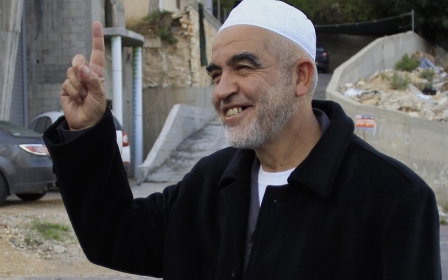Banning the Islamic Movement is a warning to us all

One of the hardest tasks for an historian is to assess a process which he knows all too well will only transpire clearly when it ends. As long as the process continues, we can observe milestones but we do not know whether they are crucial or whether they are the indicators for the completion of the process.
This dilemma comes to my mind when we come to consider the significance of the Israeli decision to outlaw the northern wing of the Islamic Movement (compounded by the arrest of its leader, Sheikh Raed Salah).
It is important to understand first what was outlawed. The movement has a charity and welfare network, an educational system and several media outlets. It has been an organic part of the Palestinian social and cultural scene in Israel since the early 1970s.
This act is therefore a delegitimisation of sizable sections of the Palestinian community in Israel.
It is not the first act of this kind. In the late 1950s, the movement al-Ard was outlawed for its support for the Palestinian national movement. This was at the time a clear signal to the Palestinian community that in pre-1967 Israel the “Israeli Arabs” could not be Palestinians - only communists or loyal Zionists.
In this respect, there are similar patterns between the al-Ard decision and the current measures against the Islamic Movement.
However, there is a huge difference between the two cases. The earlier decision was taken at a time when policymakers in Israel were still uncertain about the desired strategy towards the Palestinian minority. More than half a century later, the policy towards the Palestine question has never been clearer. Ironically, and may be inevitably, it comes at one of the worst moments in the Palestinian national movement’s history. The clear Zionist strategy is met by disunity, disorientation and a search for a new definition for the project of liberation in Palestine.
Israel’s indecision gelled into a clear-cut strategy in the beginning of this century. This strategy includes a clear vision about the future of the whole of Palestine. It is a consensual view, which explains the absence of any meaningful distinctions between the major political parties or the various governments ruling the state since 2000.
Under this vision, unfolding daily as a new reality in front of our eyes, the whole of Palestine will be under direct or indirect Israeli control. The cartography for this vision is clear: safeguarding a sizeable Jewish presence in areas which were hitherto “too Arab”: the West Bank, the Galilee, the Naqab and the mixed towns of Jaffa, al-Lid, Ramleh, Haifa, Jerusalem and Acre.
Palestinian life in this unfolding cartography of control varies according to the geographical location. Area A (now under Palestinian Authority control) of the West Bank and the Gaza Strip are ruled from the outside through a matrix of walls and fences. They are allowed autonomy. In the rest of Palestine, there is only municipal autonomy in rural Palestine and individual one in the urban centres.
Palestine as a Jewish state with shrinking pockets of Palestinian autonomy in its midst or on its margins is both a vision and the present reality.
Palestinians have reacted in various ways to this map and reality. Their reaction was conditioned by the historical memory that Israel will use all its might and power to silence opposition. The methodology of the silencing depended on the mode of actions taken by the Palestinians: near genocidal policies in Gaza and slow destruction of the infrastructure in spaces of resistance throughout the West Bank.
The success of subduing the Palestinians depends on their continued fragmentation. As long as Palestinian unity is not in the offering, this vision is safe.
Potentially, there could have been a wide coalition opposing the 2015 version of Apartheid state. But in practice there is not. However, the present-day Israeli political and security elite understand that even a fragmented society torn by national, religious and class factionalism can unite. The formation of a united parliamentary list by the Palestinians in Israel, despite all its faults, was a warning to present-day Israel of such a potential.
Silencing the Palestinian citizens in Israel always seemed a complicated process to liberal Zionists when they were in power. Aware of the need to seem democratic and yet maintain at all cost the racist nature of the state necessitated a painful navigation, which eventually failed dismally.
Around 2000, the Israeli authorities forsook such careful navigation and replaced it by an attempt to finalise the last bits in the new and clear vision. It began by laws legitimising the creation of a pure Jewish countryside and urban space. It continued with outlawing historical memory of the Nakba or forbidding any identification with the resistance movement in the occupied territories.
The toughest measures were taken first against individuals. Ousting the leader and intellectual Azmi Bishara, arresting activists and the shooting of citizens in the 2000 demonstrations were the precursors.
We are now in the next phase which is outlawing political parties. First the Islamic Movement and next will be the Tajamu’, the National Party and several NGOs which have a prominent presence in the society. The timing is informed by the progress of the new “war on terror”. The sense around Netanyahu is that the war against ISIS legitimises any act Israel wishes to take. It’s a kind of short window of opportunity to accelerate a plan that was meant to take a bit longer.
The tragedy is that the only reason why other parts of the scheme are not unfolding yet in front of our eyes is that Netanyahu is the only bulwark against his government’s wishes to go much further.
It is possible he will cave in and go further by outlawing parties and NGOs and introducing more draconian legislation in 2016. It is also possible that unexpected international alert will worry enough Israelis to bring for a short while a more balanced government to power in the next national elections.
However, such a government, which I still think is unlikely to be formed, will not undo what has already been formulated and will only slow down the process, perhaps hide it a bit better. We will still be very close to the final stages of the settler colonial project of zionising Palestine and destroying Palestinian life in it.
Defragmenting the Palestinian scene, de-Zionisation of any genuine Jewish resistance to this vision inside Israel and even a more vigorous BDS campaign are still the ingredients needed for stopping this from happening before it is too late.
The outlawing of the Islamic Movement is a warning to all of us: we cannot wait forever. We need a new leadership and orientation for the sake of all of us.
- Ilan Pappe is Professor of History, Director of the European Centre for Palestine Studies and co-director for the Exeter Centre for Ethno-Political Studies at the University of Exeter.
The views expressed in this article belong to the author and do not necessarily reflect the editorial policy of Middle East Eye.
Image: Palestinian demonstrators, seen as carrying posters and national flags, call for boycott campaign against Israeli products during a protest in Nablus, West Bank on November 22, 2015. (AA)
New MEE newsletter: Jerusalem Dispatch
Sign up to get the latest insights and analysis on Israel-Palestine, alongside Turkey Unpacked and other MEE newsletters
Middle East Eye delivers independent and unrivalled coverage and analysis of the Middle East, North Africa and beyond. To learn more about republishing this content and the associated fees, please fill out this form. More about MEE can be found here.





